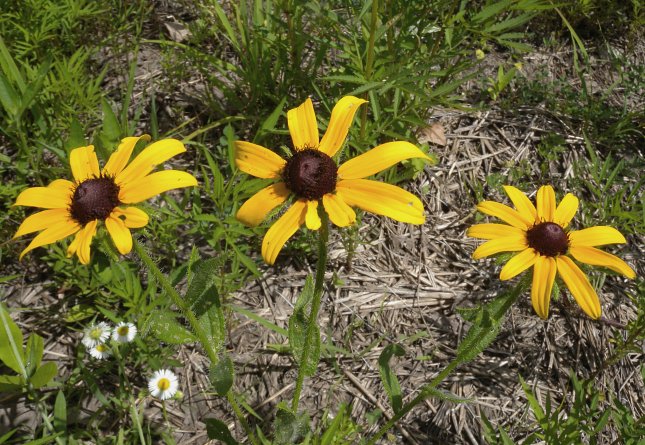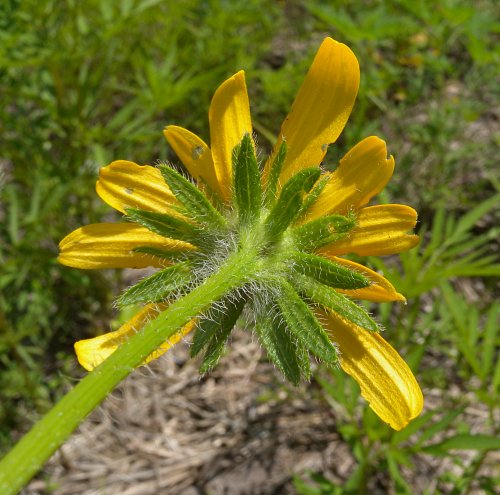Description: This is a biennial or short-lived perennial plant that is about 1-2½' tall. It occasionally branches near the base, with each stem producing a single composite flower. The stems have long white hairs. The alternate leaves are greyish green and covered with small stiff hairs, providing them with a rough texture. The leaves are up to 7" long and 2" across, and lanceolate, oblanceolate, or ovate. Their margins are ciliate and rather smooth, with or without a few blunt teeth. The basal leaves have long hairy petioles, while the middle and upper leaves have short petioles or clasp the stem.

The upper stems are long and devoid of leaves, each producing a single composite flower. This flower consists of many dark brown disk florets, forming a flattened cone, surrounded by 8-20 ray florets that are bright yellow (rarely with patches of maroon near the base). The style-tips of the disk florets are slender and pointed. Each composite flower is about 2-3" across, and has no noticeable scent. Black-Eyed Susan blooms primarily from early to mid-summer for about a month, although some plants will bloom during the late summer or fall. The achenes are black, oblong, finely nerved, and without tufts of hair. The root system consists of a central taproot and is without rhizomes – this plant reproduces entirely by seed.

Cultivation:
The
preference is full sun, and slightly moist to moderately dry soil
conditions. Any reasonably fertile soil will be satisfactory. This
plant is fast to mature and easy to grow, although short-lived.
Occasionally, there may be outbreaks of powdery mildew on the leaves in
moist environments, particularly during the fall.
Range & Habitat:
This is a common native plant throughout Illinois, and it occurs in all
counties
(see Distribution
Map). In natural habitats, Black-eyed Susan occurs in mesic
to dry prairies,
mesic to dry upland forests, particularly in open rocky areas, as well
as savannas and limestone glades. In developed areas, it can be found
in pastures and abandoned fields, areas along railroads and roadsides,
on eroded clay slopes, and miscellaneous waste areas. Black-Eyed Susan
colonizes disturbed areas readily, and recovers moderately well from
fires.

Faunal Associations: The composite flowers appeal to a wide range of insects, particularly bees and flies, as well as some wasps, butterflies, and beetles. The bees collect pollen or suck nectar, and include Little Carpenter bees, Leaf-Cutting bees, Green Metallic and other Halictine bees, Andrenid bees, and others. Some Andrenid bees, such as Andrena rudbeckiae and Heterosarus rudbeckiae, prefer visiting the flowers of Black-Eyed Susan and closely related plants. Among the flies that visit the flowers, Syrphid flies, Bee flies, and Tachinid flies are well represented. The caterpillars of Chlosyne nycteis (Silvery Checkerspot) feed on the leaves. Many mammalian herbivores are not particularly fond of the coarse leaves – they have low food value, and there have been occasional reports of this plant poisoning cattle and pigs. The seeds are eaten occasionally by goldfinches.

Photographic
Location:
The above photographs were taken at Meadowbrook Park in Urbana,
Illinois.
Comments:
Black-Eyed Susan is an excellent choice for prairie restorations, or
the first-year planting of a wildflower garden, as it may bloom during
the first year from seed. Sometimes, this plant will reseed itself with
such abandon it can become aggressive, but it will lose ground to the
longer-lived perennial plants as they mature. Black-Eyed Susan can be
distinguished from other Rudbeckia spp. by its
lanceolate hairy leaves and the long hairs on the stems; most of the
leaves occur toward the base of each stem, and never have lobes. The
species Rudbeckia fulgida (Orange Coneflower) is
quite similar in appearance, but usually blooms later, and has
style-tips that are shorter and more rounded.